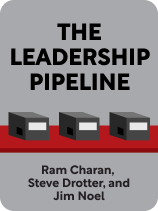

This article is an excerpt from the Shortform book guide to "The Leadership Pipeline" by Ram Charan, Steve Drotter, and Jim Noel. Shortform has the world's best summaries and analyses of books you should be reading.
Like this article? Sign up for a free trial here.
Do you want to work your way up the corporate ladder? How can you use the Leadership Pipeline to make a difference in your organization?
Understanding the Leadership Pipeline is the key to running an effective organization. Thankfully, Ram Charan has a clear definition of the Leadership Pipeline.
Let’s look at three ways organizations can use Ram Charan’s Leadership Pipeline model to improve.
What Is the Leadership Pipeline?
Ram Charan’s Leadership Pipeline model is a theoretical model for categorizing the various leadership responsibilities that employees must fulfill to keep an organization healthy. This model structures the management path into six stages or roles that employees fill in sequence as they rise through an organization. These roles are: line manager, second-level manager, functional manager, company manager, multi-company manager, and conglomerate CEO. Managers at any level who understand the Leadership Pipeline can use it to guide their decisions, helping them improve the organization.
The Leadership Pipeline is objective and universal: It describes the leadership tasks that managers in any organization need to get done to keep the system functioning, as well as the characteristics those managers need to accomplish those tasks. Your organization’s corporate structure may not match the Leadership Pipeline perfectly, but it must have someone assuming the responsibilities for each of these roles. For instance, in smaller companies, one manager might need to do the jobs of two different Pipeline stages.
| Management Responsibilities Are Universal; Mission Specifics Aren’t The Leadership Pipeline exclusively describes the management responsibilities that need to get done—it doesn’t specify any of the mission-specific tasks your organization needs to execute. For instance, the Leadership Pipeline states that a Functional Manager (a manager in charge of a department) must decide on a big-picture strategy for their department, but it doesn’t provide any guidance as to what that strategy should be. This is because management responsibilities are universal, while mission-specific tasks differ between organizations. The fact that different kinds of organizations have different missions is another reason why your organization’s formal corporate structure may vary from the six stages the authors describe. Experts explain that organizations must tailor their structure to their mission to achieve the best results. For example, if a company is mostly composed of front-line workers doing tasks that require very little management—say, a temp agency where each front-line worker gets temporarily coached by a different organization—they may not need any line managers to coach individual performance. |
In the next section, we’ll describe the six stages of the Leadership Pipeline. But first, you might be wondering how you can use this knowledge to improve your organization. We’ll explore three of these uses.
Use #1: Help All Managers Grow
First, according to the authors, you can use the Leadership Pipeline to ensure that every manager is learning how to better do their job—and future jobs. Because the Pipeline describes what managers at each level need to do their job well, you can clearly identify when they’re doing something wrong and explain how they can improve.
(Shortform note: The Leadership Pipeline gives all employees the chance to receive continuous feedback from a supervisor based on objective metrics. These are some of the conditions required for deliberate practice, the scientifically-backed process that Olympic athletes use to hone their elite skills.)
Furthermore, the authors say, the six stages of the Leadership Pipeline build on one another—the requirements to excel at one stage are all prerequisites for excellent performance at the next stage. Thus, managers working according to the Leadership Pipeline are constantly preparing for greater responsibility in future roles.
In contrast, many organizations promote employees before they’re ready, giving them high-level management responsibilities without first allowing them to develop the necessary skills and mindset. Consequently, employees with high potential end up floundering in their new roles. Without a system in place to give employees the experiences they need to grow, it doesn’t matter how much potential they have.
| Willingness to Learn Can Compensate for Lack of Experience Although Charan, Drotter, and Noel contend that high-ranking managers need a wealth of experience from every previous stage to succeed, this is arguably not a hard-and-fast rule. Even if a worker gets promoted to a managerial position before they’re ready, the only way they’ll permanently flounder in that role is if they continuously fail to learn anything. Luckily, learning on the job isn’t too hard: According to Ray Dalio in Principles, it’s possible to get continuously better in any role, even without formal experience or systematic coaching. Dalio offers a simple formula for finding success through trial and error, asserting that “Pain + Reflection = Progress.” When a manager makes an embarrassing mistake, it’s painful. However, that pain always serves as an opportunity to learn. If they can reflect on that pain and discover a way to avoid it in the future, they’ll get better at whatever job they have. According to Dalio, the key to learning from pain is total receptivity: being open-minded enough to consider the possibility that you’re wrong about anything. If a manager is willing to try out the strategies that other people offer rather than stubbornly clinging to a failing strategy of their own, improvement is virtually inevitable. |
Use #2: Identify Your Organization’s Flaws
Second, you can use the Leadership Pipeline to identify imperfections in your organization and work to resolve them, the authors write. As we’ve discussed, the Pipeline offers a model for ideal management at any level. When a manager doesn’t match the model, it means their work is flawed and someone needs to correct or coach them.
The authors note that the Leadership Pipeline is particularly good at identifying hidden management flaws. Some flaws are obvious: It’s easy to notice when a manager does poor work or fails to complete all their tasks. However, without the Leadership Pipeline, it’s difficult to notice when a manager is working hard on the wrong tasks.
According to the authors, this typically happens when a manager doesn’t understand their role and instead does work that’s easier for them to understand: the work from the stage below that they did before being promoted. Not only do such managers fail to fulfill their unique responsibilities, they also prevent their subordinates from getting the experience they need to advance to the next stage. Thus, they disrupt the entire Pipeline, halting the growth of numerous employees and weakening the company’s future leadership.
For example, imagine that the manager of an IT department likes to jump in and solve tech issues themselves whenever their team faces a complex problem. In doing so, they’re teaching their subordinates to pass off challenges to others instead of taking personal responsibility for the team’s mission. As a result, none of the members of this IT team will have what it takes to become managers in the future.
The Leadership Pipeline helps you identify situations like this by delineating the exact tasks managers at each level should be doing. A second-level manager who’s familiar with the Leadership Pipeline would take a look at the aforementioned hands-on IT manager and immediately realize that they’re doing front-line work rather than management work.
Use #3: Make Better Staffing Decisions
Third, the authors explain that the Leadership Pipeline helps those in charge make better decisions regarding who gets promoted and when. By clearly defining the skills and mindset that managers need to thrive at each stage, the Pipeline sets standardized, more effective criteria for these staffing decisions: When a manager fulfills their current role exceptionally well, the manager above them should test them by assigning them some responsibilities of the next stage. Then, if they show that they’re capable of handling this increased responsibility, they’ll be eligible for a promotion.
(Shortform note: If a manager fails after you test their ability to handle increased responsibility, you may have to deny them a promotion they expected to earn. If they feel like their work isn’t being appreciated or rewarded with career progression, it may crush their spirits and cause them to disengage from their work. To avoid this, experts recommend using the meeting where you tell them they’re not being promoted as an opportunity to give them a renewed sense of purpose and direction. Emphasize that you recognize how hard they’re working and that you believe in their potential to do even more. Then, discuss how you can develop a plan for them to gain the experience they need to increase their chances of earning the promotion in the future.)
Without the Leadership Pipeline, the authors say, leaders decide who to promote based on ineffective metrics, such as past performance. Evaluating workers by past performance is much less reliable than it seems: Because each role requires a different skill set and perspective, an employee’s stellar performance in one position doesn’t guarantee success in a higher one.
(Shortform note: In High Output Management, Andrew Grove disagrees, arguing that promotions need to be given on the basis of performance. Whenever a manager promotes someone, they’re signaling to everyone else on the team that this employee is a role model. If you promote someone who’s not an obvious high performer, you risk implying that high performance isn’t recognized or important in your organization. That said, if you’re basing your promotions on a specific set of criteria (as the Leadership Pipeline recommends), it’s likely that you can avoid this kind of miscommunication by directly communicating the rationale behind every promotion to your whole team.)

———End of Preview———
Like what you just read? Read the rest of the world's best book summary and analysis of Ram Charan, Steve Drotter, and Jim Noel's "The Leadership Pipeline" at Shortform.
Here's what you'll find in our full The Leadership Pipeline summary:
- Why most organizations end up full of unqualified managers
- The six different levels of management necessary to run any large organization
- The biggest mistake CEOs make that holds them back from success






